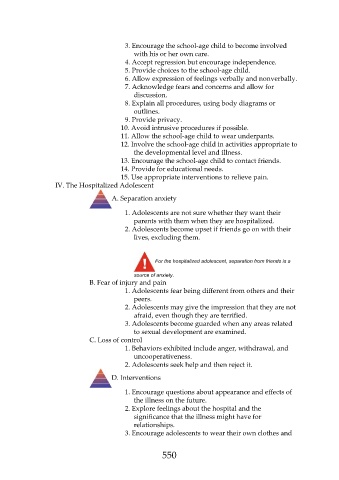Page 550 - Saunders Comprehensive Review For NCLEX-RN
P. 550
3. Encourage the school-age child to become involved
with his or her own care.
4. Accept regression but encourage independence.
5. Provide choices to the school-age child.
6. Allow expression of feelings verbally and nonverbally.
7. Acknowledge fears and concerns and allow for
discussion.
8. Explain all procedures, using body diagrams or
outlines.
9. Provide privacy.
10. Avoid intrusive procedures if possible.
11. Allow the school-age child to wear underpants.
12. Involve the school-age child in activities appropriate to
the developmental level and illness.
13. Encourage the school-age child to contact friends.
14. Provide for educational needs.
15. Use appropriate interventions to relieve pain.
IV. The Hospitalized Adolescent
A. Separation anxiety
1. Adolescents are not sure whether they want their
parents with them when they are hospitalized.
2. Adolescents become upset if friends go on with their
lives, excluding them.
For the hospitalized adolescent, separation from friends is a
source of anxiety.
B. Fear of injury and pain
1. Adolescents fear being different from others and their
peers.
2. Adolescents may give the impression that they are not
afraid, even though they are terrified.
3. Adolescents become guarded when any areas related
to sexual development are examined.
C. Loss of control
1. Behaviors exhibited include anger, withdrawal, and
uncooperativeness.
2. Adolescents seek help and then reject it.
D. Interventions
1. Encourage questions about appearance and effects of
the illness on the future.
2. Explore feelings about the hospital and the
significance that the illness might have for
relationships.
3. Encourage adolescents to wear their own clothes and
550

